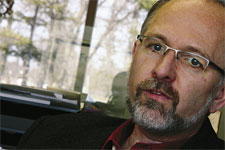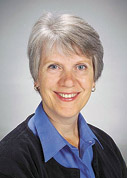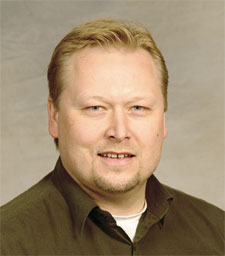Canadian Mennonite
Volume 11, No. 21
October 29, 2007
Readers Write
We welcome your comments and publish most letters sent by subscribers intended for publication. Respecting our theology of the priesthood of all believers and of the importance of the faith community discernment process, this section is a largely open forum for the sharing of views. Letters are the opinion of the writer only—publication does not mean endorsement by the magazine or the church. Letters should be brief and address issues rather than individuals.
Please send letters to be considered for publication to letters@canadianmennonite.org or by postal mail or fax, marked “Attn: Letter to the Editor” (our address is on page 3). Letters should include the author’s contact information and mailing address. Letters are edited for length, style and adherence to editorial guidelines.
Scripture, not science, the key to a proper understanding of God
John 5:39-40 states: “You search the Scriptures because you think that in them you have eternal life; and it is they that bear witness to me; yet you refuse to come to me that you may have life.”
In a generation that is used to fiction, entertainment and storytelling, it is easy to look at Scripture the same way. We assume that what is written in the Bible happened fictionally. We assume that the miracles presented are a nice story—but only a story. We assume that what God says happened must be fiction because it doesn’t fit our everyday experience. This is the general perception of the world concerning Scripture, that it is a nice bunch of stories or myths. Some place their trust in their interpretation of it, so that they become ensnared in our own understanding.
Jesus said we search the Scriptures to find him. Searching Scripture is not wrong, but our focal point may be. Do we search the Scriptures to prove our bias right or to allow God to speak to us?
We place more importance on what we can observe or prove than on the revelations of the Holy Spirit. We tend to accept what scholars say rather than our own personal search of the Scriptures.
Instead of Scripture being read with a heart of faith, now there seems to be a push to read with science’s criteria. What happened to “God said it; I believe it”? Unknowingly we have eaten of the same fruit that Eve did.
What is the way back?
- Accept what God say to be true, search God rather than human knowledge. (Knowledge will come as we trust and fear God first.)
- Science is of human origin; it will never lead us to God.
- Accept God’s absolutes, not our own understanding.
- Acknowledge that God knows more than we do.
- God is always trustworthy; humans are not.
- Obey God rather than humans. Proverbs 1:7 says, “The fear of God is the beginning of wisdom.”
As an example of faith run amok, look at what happened to Israel whenever godly wisdom was rejected. It eventually cost them deportation to Babylon. Are we any better than they? No we are not, and church history bears me out in this. The Reformation came because humans had fallen into misguided unbelief. We are now on the brink of doing it again.
What games are suitable for Mennonite children to play?
Is that Battleship the boys are playing on the back cover of the Aug. 20, 2007, issue of Canadian Mennonite?
(The game is, in fact, Battleship, and the suitability of just such a game for Mennonite children was brought to the floor of the Abbotsford assembly after the photograph originally appeared in the assembly newsletter. Ed.)
Potter accused of witchcraft, The Simpsons of mockery
When I read the book review on Harry Potter (“Vanquishing Voldemort: Why Harry Potter had to be a wizard,” Sept. 3, 2007, page 26), I was shocked, since we went through that whole thing after the first Harry Potter book came out. I believe Anabaptist Mennonites teach their children faith in God through the Bible. Yes, there are fairytales, but Harry Potter is witchcraft.
And that review of The Simpsons Movie (“Does The Simpsons Movie demean Christianity? Doh!”) on the next page. The whole Simpsons franchise is one big mockery of God.
Redesign of magazine lauded by former publisher
Congratulations on the successful launch of a new design! I got my Sept. 3 issue and it’s exciting and satisfying to see Canadian Mennonite reaching for ways to stay fresh and relevant. I appreciated Helmut Harder’s rationale for a church paper 10 years ago (see “Ten years of ‘a good thing,’” Sept. 3, 2007, page 2). And I agree that the rationale is as relevant today as then.
Warts and all, Mennonites are aware of their calling to follow Jesus
In my opinion, Phil Wagler’s “Menno idol” column (Sept. 17, 2007, page 8) starts off on the wrong foot. “Are we Mennonite or Christian?” is a bit like asking, “Are we farmers or golfers?”
Wagler uses the pronouns “we” and “us” a lot, as if we Mennonites were a monolith. When he says, “We seem, five centuries later, happily captivated by our ethnic religious genius,” I really don’t know what he’s talking about. “My Mennonites” are well aware of their warts, and just as convinced as early Anabaptists ever were that their calling is to serve in the redemption of a battered world by following in Jesus’ footsteps.
I particularly take exception to the comment, “We have turned Menno into an idol, Jesus into an available option on our proudly humble ethnicity, and we risk no longer being his church built upon the rock.” From where I sit, this describes nothing real. If anything, we have foolishly neglected the witness of Menno Simons and his fellow Anabaptists, and have come to idolize the North American version of fundamentalist Christianity that tends to reduce the gospel to “born again” clichés and spirituality focused too exclusively on personal salvation and emotional stroking.
The story of the Old Testament is centred on the Exodus, a series of events by which God established an ethnic peoplehood through which he intended to bless the world. It is not a mighty stretch to see the Anabaptist movement as God’s establishment of another ethnic peoplehood through which he, similarly, meant to bless the world.
I don’t think I’m proud to be a Mennonite, much less that I idolize the fact, but I am thankful that I was born into the culture that I was. If Wagler is saying that we need to keep the essential gospel firmly at the centre of our work and worship, then he’s absolutely right. In the end, our ethnic identity is a transient matter; to found a faith and way of life on it would be foolhardy.
Time to consider commissioning vegetable farming ministers
Will Braun’s New Order Voice column, “One hundred mile grace,” in the Sept. 17 issue of Canadian Mennonite is a kind of retread of some old ideas.
Over the past 30 or more years various groups of people, both in the U.S. and Canada, have talked about developing a land trust whereby people would buy shares in farmland that would, in turn, be rented to farmers. The ideas revolved around three goals:
- First, to assist farmers who were going bankrupt due the successive farm crises.
- Second, to help those farm families where inheri-tance issues made the land too pricey for one family member to continue farming when other family members wished to have their farm inheritance in cash.
- Third, to provide some new opportunities for growing local produce somewhat along the lines of the 100 Mile Diet. Unfortunately, it was another one of those ideas that seemed good at the time, but sputtered and died.
Perhaps it is time to revisit the old idea of land trusts and meld it with commissioned vegetable farming ministers. Perhaps we need to look at other issues, such as preserving—developing a local canning facility, as many of us are too busy to do that ourselves—where we know what is going into the can. Perhaps what we really need to do is to move this entire issue of food higher on our agenda within the church.
Farm implement ad approved, travel, banking ads criticized
Re: “Ad not relevant to readers” letter, Sept. 17, 2007, page 12.
We question why the Tremzac ad seemed to bother the letter writer so much, since Tremzac is an environmentally responsible product.
Right across the page was a TourMagination ad encouraging us to worldwide travel, which pollutes our atmosphere with every take-off and landing.
Add to that the ads for investments that earn rates of interest that, for the most part, can only be called usury.
Unfortunately, Canadian Mennonite requires advertising revenue to keep subscription rates reasonable. If we truly wish to nitpick, we would be eliminating most of the advertising.
From Our Leaders
Searching for thick faith

Christian Formation Council just finished holding its fall meetings in Saskatoon. Among the things we spent time on was a “futures thinking” exercise in which we asked what areas of ministry the council might discern as needing attention in Mennonite Church Canada in the near- and longer-term future.
One item at the top of the list was the matter of ministry to seniors. While the discussion was inclusive of those who are currently seniors, we spoke much more about the large contingent of Canadians, including Mennonites, who will be turning 65 in the next 15 years—by some estimates, approximately 11 million people (fully a third of our country’s population).
[H]ow can we plan as a church to thicken the faith of this generation?
The upcoming seniors demographic on the whole is less likely than their parents to engage in regular spiritual practices such as Bible reading, intentional times of prayer, attending adult Christian education on a weekly basis, or participating in smaller, more intimate study groups for spiritual growth.
For many, regular worship attendance means going to church one or two times a month, with summers for “lake time” and a few weeks in winter off for vacation. The result is a whole generation of older adults who, despite being raised in church, do not regularly have significant encounters with the Bible, nor do they have extensive experience with the church as a living faith community. We might describe their faith as rather thin, based more on casual exposure than intensive encounter and engagement with God and God’s real-life people.
Given that as we age we begin to ask weightier questions about faith, life and mortality, how can we plan as a church to thicken the faith of this generation? How can we help people become deeply rooted in the story of a God who wants to nurture an intense relationship with humanity through the ages? How will we invite so many soon-to-be seniors into the life of the church, a community refined in the crucible of persecution and testing, and in the Scriptures as a continuing revelation of the character and intention of God in Jesus Christ?
The exploration of the council offered no easy answers to this gargantuan challenge, but several thoughts emerged:
- Can we begin now to produce faith-forming resources that are able to speak in plain language about the nature of God, the significance of Jesus Christ, the movement of the Holy Spirit, the role of the Bible, and the place of Christianity among diverse world faiths?
- Can we create spaces in our congregations that welcome any inquiry or topic of discussion without criticism or judgment, but rather as an opportunity to identify the movement of the Spirit in our midst, and the presence of the truth of God in the world?
Family Ties
Fourth step to a good hug

My mother has been known to say, “I wish you were all still babies that I could hold on my lap.” The first time I heard these words, a comical image popped unbidden into my head as I saw my mother’s eight children, all grown to adulthood, vying for space in her willing, yet limited lap. Having made my own journey as a parent of an infant who became an adult, I better understand the sentiment behind her comments.
Parents know as well as anyone that the time comes for a hug to end. Children are always moving away from the parental embrace. When the preacher says, “There is a time to embrace and a time to refrain from embracing” (Ecclesiastes 3:5b), a father or mother nods in agreement, although they might wonder whether now is a time when their child, big or little, needs to be held or needs to be free from parental arms.
Whatever the timing, there is no arguing that hugs end. As theologian Miroslav Volf says in Exclusion and Embrace, “The other must be let go so that . . . her genuine dynamic identity—may be preserved. . . .”
May our hugs draw us closer to each other, and to God.
This moment of release is the fourth step in a good hug. The previous steps of opening one’s arms, waiting for the other’s response, and embracing, conclude when the hugger opens his or her arms and releases the huggee. Volf says that all four steps must be included in order for the hug to be a hug. Without step three, it’s an “aborted embrace”. Without step four, the act of love is “pervert[ed] . . . into an act of oppres-sion. . . .” While we may know precisely what he means, it may still be difficult for us to practise the moment of release when we are the huggers.
Our different personalities feed into the challenges we have with hugs. Some of us struggle more with the first step of hugging, that of simply being vulnerable and opening our arms. Others miscue on waiting for the other’s response. Some of us have difficulty savouring the moment of embrace, while others resist the moment of release. There are cultural differences related to touch, who may or may not touch whom and under what circumstances. And, of course, there are different kinds of hugs.
Not all hugs can, or should, feel the same. A hug offered during a family reunion is different than a hug received at a time of grief or tragedy. Sibling hugs may carry memories of the family history they share. Hugs exchanged between lovers reflect their sexual bond. When both huggers are adults, the message is often different than that conveyed by adult-child hugs. Most significantly, if the hug is going to be a good hug, it is so only because the huggee desires intimacy with the hugger, just as the hugger has desired the intimacy with the huggee. May our hugs draw us closer to each other, and to God.
Soon I’ll be visiting my mother. We’ll both enjoy the long history between us, and there will be good hugs, incorporating all four steps! But I don’t plan to climb onto her lap!
God, Money and Me
Payday loans and cash advances

The demand for immediate cash and short-term loans is so profound that in a decade the payday loan industry has grown from zero to 1,400 outlets in Canada and continues to expand. The names on the storefront may vary, but the services are virtually the same: provide small, short-term loans, cheque-cashing, and cash advances from a non-traditional lender—for a fee.
A 2006 public interest article produced by the Parliamentary Information and Research Service explained the details of an actual short-term loan: $400 was loaned at a cost $51.28 plus the original amount. That is a nominal interest rate of 12.82 percent annually. However, in this case the loan was for only 17 days. When the payday loan is calculated based on 365 days, the effective interest rate balloons to 1,242 percent.
The wisdom of Proverbs 22: 7—‘the borrower is slave to the lender’—couldn’t be more appropriate.
Section 347 of the Criminal Code of Canada makes it a criminal offence to charge more than a 60 percent effective interest rate. Interest rates beyond this amount are illegal and referred to as predatory lending.
So how is an interest rate of more than 1,000 percent possible? Unlike banking and investing, the payday loan business is relatively unregulated. The Canadian Payday Loan Association does have a code of conduct, but is a self-regulatory body and membership is voluntary. By using the term “fee” in place of “interest,” payday loan companies have made prosecution under the Criminal Code more difficult. Consumers seem to be okay with the high cost of borrowing money when it is called a fee, not interest. The cost of borrowing the $400 was promoted by the payday loan company as follows: interest—$8.64; per item fee—$9.99; cheque-cashing fee—$32.65; principal—$400. Total cost is $451.28.
The type of person who uses a payday loan service is not necessarily the person you might expect. In a 2005 study by the Financial Consumer Agency of Canada, more than half of the respondents cited convenience as the No. 1 reason for using these services, while only 14 percent cited credit and banking issues. What that means is that a large number of people are using this type of expensive credit even though cheaper options are available to them. Either they don’t know—or don’t care—about the high cost payday loan companies charge.
It is understandable that payday loan companies have found a niche market, but that doesn’t mean you need to be part of it. If you use, or are tempted to use, payday loan services, have a look at alternative lenders such as your bank or credit union first. Even a cash advance on a credit card will be less costly than most payday loans.
Practise restraint. Is your need for immediate cash going to be used to satisfy a need or a want? If it is a want, you are better to do without it than incur heavy borrowing costs. If you have any doubts about your ability to manage money or make financial decisions, talk to someone who can help you—a financial planner, your bank or credit union, or Mennonite Foundation of Canada.
The wisdom of Proverbs 22: 7—“the borrower is slave to the lender”—couldn’t be more appropriate than in the case of payday loan services. Wise management, fiscal restraint and practising contentment are as much a part of biblical stewardship as is learning generosity.
Young Prophets
Bridging the solitudes
 |
There’s something unnerving about staring into the headlights of oncoming traffic. I tend to get a panicky feeling in my stomach when I realize the taxi I’m in is not going with the flow of traffic, but rather driving against it. But aggressively driving against traffic became a common occurrence for me after I accepted a teaching position at a private high school in Cairo last year. Similarly, I found that many aspects of life overseas frequently came at me from opposing and unexpected directions.
I arrived in Egypt in late August during a heat wave. I have never felt such intense and suffocating heat. Images that I had had of sandy beaches, golden pyramids and boulevards lined with palm trees were tempered by the reality of the regional conflict between Israel and Lebanon. And the traffic terrified me.
I found life in Egypt difficult to adjust to. Things are very different. As a single, white female I was often singled out from those around me. There was the verbal and sexual harassment on the streets and the expectation that I would pay inflated prices at the markets.
Any attempts at giving personal expression to my faith seemed to be inconsequential and drowned out by the practices of the prevailing culture and faith.
On the other hand, the preferential treatment that was accorded me, a westerner, was another matter that offended my personal sensitivities. I earned more than my Egyptian co-workers who did the same work. Because of where I taught, I lived among the wealthiest foreigners in the country. I was given priority seating at soccer matches while surrounded by armed security personnel. I was allowed entry to exotic resorts and was always welcome at the Four Seasons Hotel.
While these gestures were meant to welcome and accept me, they left me with a growing sense of isolation and seclusion. I felt a growing divide between the “me” and “them,” and wondered to what extent these solitudes could be bridged.

To look back on my experience from a faith perspective remains a challenge. I still am unclear as to how to interpret and understand the impact that my experience in Egypt had on my Christian faith. Living in a predominately Muslim culture, but having limited opportunities to relate to Muslims, I felt very out of place. Any attempts at giving personal expression to my faith seemed to be inconsequential and drowned out by the practices of the prevailing culture and faith.
Located not far from where I lived, the Maadi Community Church proved to be a place of refuge. It was here that I experienced peace and security, and received encouragement in my faith pilgrimage. It was here that I could ask my questions and share my doubts and frustrations.
Familiar songs of praise and worship were sung here and, while they could not compete with the loud echoes of the neighbourhood mosques, they provided me with the sense of community and the acceptance that I needed.
Staring wide-eyed into oncoming traffic made me feel vulnerable and scared. Meeting glaring disparity and inequality head-on was something I often wanted to run away from. Now back in North America, my tendency is to go with the flow, travel with traffic instead of against it, get behind the wheel myself, but I don’t want to forget that fear-induced adrenaline. Knowing that much of the world experiences a different reality, I need to keep my eyes and heart wide open, alert to being a faithful and responsible Christian sojourner. I am still discerning what this means.